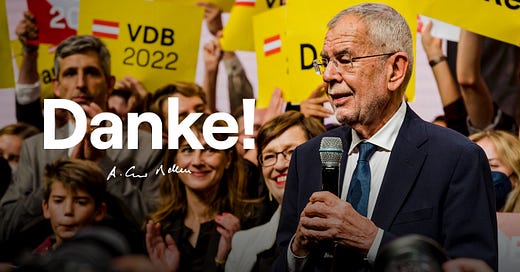VDB Redux
Incumbent president Alexander Van der Bellen won 56.7 percent of the vote in Sunday's election, putting him miles ahead of his opponents, avoiding a second round vote
Servus!
The polls had it more-or-less right. The final Heute/profil survey published before Sunday’s presidential election showed that the incumbent Alexander Van der Bellen would win more than 50 percent of the vote in the first round, avoiding the need for a second. In the end, Van der Bellen captured 56.7 percent of the vote, putting him miles ahead of his closest competitor, the far-right Freedom Party (FPÖ) candidate Walter Rosenkranz on 17.7 percent. As predicted, it wasn’t even close.
The most competitive race was for third place between the Beer Party candidate Dominik Wlazny (8.3 percent) and tabloid columnist Tassilo Wallentin (8.1 percent), who had financial support from the billionaire businessman Frank Stronach and institutional backing from the Kronen Zeitung. Wlazny performed particularly well among voters in Vienna as well as those under 30, indicating his potential to use the presidential contest as a platform for his joke Beer Party ahead of elections for the Austrian parliament due in 2024.


Behind Wlazny and Wallentin were the populist Gerald Grosz (5.6 percent), MFG candidate Michael Brunner (2.1 percent), and left-wing ‘esoteric’ Heinrich Staudinger (1.6 percent). Brunner and Staudinger were the two explicit vaccine-skeptic candidates in the race, and their relatively poor performance indicated the limited potential of COVID-skepticism as a standalone political movement in 2022. Its fortunes are now closely tied to those of the FPÖ.
The FPÖ’s Rosenkranz came out on top in a handful of districts, in particular in the southern state of Carinthia, a heartland of the far-right since the time of Jörg Haider. But broadly speaking, the night was Van der Bellen’s. The incumbent won all of Austria’s nine states, performing especially well in Vienna and its commuter belt as well as in the western states of Tyrol and Vorarlberg. His core voter groups were those over the age of 60 (73 percent), the university-educated (69 percent), and those who believed the country is headed in the right direction (75 percent).
Rosenkranz suffered from the splintering of the populist right-wing vote. In 2016, the FPÖ’s presidential candidate Norbert Hofer won almost 2 million votes in the second round against Van der Bellen. Of those 2016 voters, only 613,000 voted for Rosenkranz in 2022. The FPÖ lost almost half a million voters to Van der Bellen, around a quarter of a million to Wallentin, and 165,000 to Grosz. Another 178,000 stayed home this time around (though 92,000 voters who didn’t vote in 2016 voted for Rosenkranz in 2022).


Van der Bellen’s victory was one for the broad center of Austrian politics, the tradition of presidential re-elections, and for the incumbent personally, who ran on being an island of stability and continuity amidst a sea of troubles. His first-round victory with 56.7 percent of the vote was more than respectable considering the sheer number of opposition candidates—six, unprecedented for an election with an incumbent president and staggering considering that the People’s Party (ÖVP), Social Democratic Party (SPÖ), Greens, and NEOS all chose not to run a candidate against Van der Bellen.
So unusual was this election that it is hard to discern what the future might portend, but if there were two causes for concern, it would be these. First, that Van der Bellen did so much better with voters over 60 (73 percent) than under 60 (47 percent). Wlazny won 20 percent of voters under 30, while Rosenkranz won 22 percent of voters aged between 30 and 59. Second, that the incumbent won 62 percent of voters who said they were able to live off their current income but only 39 percent of voters who said they couldn’t. Rosenkranz, Wallentin, and Grosz did far better with the latter than the former. As inflation bites, the less well-off may constitute a pool of voters from which the far-right can draw.
Bis bald!
Thank you for being a subscriber to the Vienna Briefing. If you know someone else who might be interested in reading this newsletter, consider sharing it with them today.
The Vienna Briefing is a free newsletter. If you enjoy and would like to support my work, think about sending me a tip via PayPal.
Stagflation?
Austria is headed towards stagflation. Two of the country’s leading economic research institutes, Wifo and the IHS, published figures last week predicting that in 2023, economic growth will slow while inflation will remain high.
Mask Mandate?
The government is debating whether or not to reintroduce a nationwide mask mandate on public transport, in shops, and in other closed spaces as COVID-19 case numbers soar. While the Greens are believed to support such a mandate, the ÖVP remains hesitant. The government has until October 23 to decide, at which point existing COVID-19 countermeasures will expire.
Whither Lueger?
“Lueger Temporär,” a temporary art installation at the site of the controversial monument to Vienna’s former mayor, the antisemite Karl Lueger, was unveiled on Wednesday morning. “Lueger Temporär” is intended as an act of artistic contextualization. A permanent installation will be selected in 2023.





